Some of Mexico’s key population indicators are listed below, with the latest estimates of the 2010 values for each indicator: Total population – 108.4 million Crude birth rate – 17.8 / 1,000 Crude death rate – 5.0 / 1,000 Natural population growth rate – 1.28%/yr Infant mortality rate – 14 / 1,000 live births Total […]
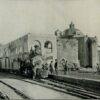
As mentioned in a previous post about tourist guidebooks, the introduction of railways into Mexico and the gradual expansion of the railway network encouraged the development of all kinds of social, industrial and tourist activities. The Mexico City-Puebla line was completed in 1886 and went via the small town of Cuautla in the state of […]
Mexico’s most valuable brands

Consultancy firm Brand Finance recently published its fifth annual survey (2010) of the world’s 500 most valuable brands. The Mexican firms in the list are: Corona (# 184) – principal product – beer Banorte (#189) – finance and banking Claro (#262) – cell phone service Telcel (#290) – cell phone service Bimbo (#369) – bread […]
The origins of the cabañuelas system of weather forecasting
An earlier post described the weather forecasting system known as las cabañuelas. In this post, we look at the possible origins of such an unusual and distinctive system. Is the term cabañuelas derived from the Mayan language? The historical origins of the word cabañuelas are unclear. Some sources claim that the system’s roots lie in […]
Baseball is not the oldest ballgame in the Americas
Forget modern “traditions” like the World Series! Forget soccer, tennis and golf! By far the oldest ballgame in the Americas is the little known game of Ulama. Amazingly, this game is still played in some regions of Mexico, where it is believed to have originated more than 3000 years ago! The precise rules of the […]
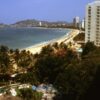
Mexico is one of the 30 member states of the OECD (Organisation for Economic and Commercial Development). Of all these countries, Mexico, Spain and Portugal are the three whose economies gain most from tourism. In Spain, 11% of its GDP comes from tourism, in Portugal 10.5% and in Mexico 8.2%. Employment in Mexico is also […]
Map of Baja California Peninsula
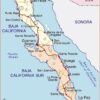
The map shows Mexico’s Baja California Peninsula. This includes the states of Baja California, the northern section of the peninsula, and Baja California Sur. The state capital of Baja California is Mexicali; the state capital of Baja California Sur is La Paz. Note: There is no such state as Baja California Norte, despite this name […]
The development of railways led to tourist guide books
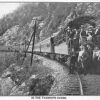
In the golden age of steam, railway lines were built all over Mexico. Rail quickly became THE way to travel. Depending on your status and wealth, you could travel third class, second class or first class. Anyone desiring greater comfort and privacy could add their luxury carriage to a regular train. To avoid mixing with […]
The geography of cholera in Mexico
When Mexico braced herself for the imminent arrival of cholera from South America in 1991, many people believed that the disease had never previously been known here. However, during the 19th century, there were several outbreaks, including the epidemic of 1833 in which more than 3,000 people died in the city of Guadalajara alone. A […]
Mexico’s top yachtsman wins the first round-the-world yacht race.
The first Whitbread Round-The-World yacht race was won by a Mexican. Most people do not associate Mexico and Mexicans with yachting, but it’s a fact that the first Whitbread Round-The-World Yacht Race, in 1973-4, was won by the Mexican ketch Sayula II, skippered by Ramón Carlin, a Mexican businessman who made his money from washing […]
Mexico has the world’s 11th largest economy
These are the world’s 14 largest economies (GDP, purchasing power parity, 2008, in US dollars): USA 14,960 billion China 7,800 billion Japan 4,487 billion India 3,319 billion Germany 2,863 billion UK […]
Review by John Pint in MexConnect
John Pint, one of Mexico’s best known cavers and explorers, and author of “Outdoors in Western Mexico”, has reviewed Geo-Mexico: the geography and dynamics of modern Mexico for MexConnect e-zine. In Pint’s view, Rhoda and Burton tell us that geography as a subject is — like Mexico itself — “often under-appreciated, equated with memorizing the […]
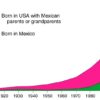
Mexicans have a long history of working and living in the USA. Migration is one of the most important linkages between North America’s two most populous countries. The Mexican diaspora in the USA is an integral part of both Mexican and US society. Each year roughly 250 million legal border crossings are made, about half […]
A brief history of geography in Mexico
Mexico has a long tradition of geography. Modern geography was given a jump-start in the country by the brilliant Prussian traveler Alexander von Humboldt, who explored Mexico for twelve months in 1803–04. The Mexican Society of Geography and Statistics was founded in 1833, only three years after the UK’s Royal Geographical Society and fully 55 […]
Mexico’s Spanish language place names
The Spanish language is at least as rich as English when describing landscapes. Common Spanish geographical terms relating to landscape include: cerro = hill montaña = mountain sierra = elongated mountain range mesa = flat-topped (table) hill cumbre = summit or peak pico = sharp peak valle = valley barranca = canyon cenote = limestone […]
Mexico’s indigenous place names
Mexico’s place names, or toponyms, offer many clues about geography. Mexico’s indigenous peoples spoke languages that had no formal alphabet. For place names, they used combinations of pictographs, ideographs and phonetic symbols. Spanish explorers recorded the names provided by the locals as best they could, resulting in some inevitable confusion and distortion. For instance, it […]
Mexico’s ecological footprint compared to that of other countries
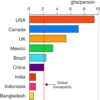
The ecological footprint of a country is defined as the area of land (and water) required by a population, given prevailing technology, to produce the resources it consumes and to absorb any wastes created. Ecological footprints are measured in ‘global hectares’ (gha). A global hectare encompasses the average annual productivity of all biologically productive land […]
Giant whirlpool swallows several boats in 1896
An anonymous writer in the Los Angeles Times edition of 13 January 1896, reported on a strange and terrifying happening that struck the western part of Lake Chapala (Mexico’s largest natural lake)… Startling Spectacle at Lake Chapala. Its Waters Swallowed by a Subterranean Cave. Several Pleasure Boats and Their Occupants Engulfed. SAN DIEGO, Jan. 12.—(Special […]
One of Mexico’s earliest geographers
José Antonio Villa-Señor y Sanchez, born in Mexico in about 1700, is one of the earliest Mexican geographers. He studied at the College of San Idelfonso in Mexico City, and was later employed in the collection of taxes, becoming comptroller of revenue from mercury (a chemical essential to the refining of silver ores). He was […]
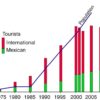
Mexico’s mass tourism industry in the past forty years has been dominated by large-scale, purpose-built developments partially funded by federal funds. In 1967, responding to bullish predictions of US demand for beach vacations, Mexico’s central bank identified the five best places for completely new, purpose-built tourist resorts. Top of the list, as part of a […]
The Aztecs knew their geography!
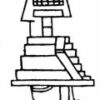
Aztec place glyphs drawn in the 16th century Codex Mendoza suggest that the Aztecs had all the major branches of geography covered. Physical geography Poctépec = hill that smokes (volcano) Human geography Teocalcingo = where the temple is Economic geography Michmaloyan = place to fish The Aztecs clearly knew their geography! [Extract from chapter 1 […]
The geography of Mexican cuisine
Mexican cuisine is extraordinarily varied and has become one of the most popular in the world. Diana Kennedy, the foremost authority on the subject, has devoted her life to researching the regional variations in ingredients, cooking methods and typical local dishes. The ingredients used reflect different climates and ecosystems (see Geo-Mexico chapters 4 and 5). […]
Mexico’s population in 1990, 2010 and 2050
Want your very own Geo-Mexico bookmark? This link – Population of Mexico in 1990, 2010 and 2050 – is to a pdf file of three age-sex pyramids showing the population of Mexico in the years 1990 and 2010, and the predicted population for the year 2050. Print the file to make your own Geo-Mexico bookmark […]
Mexico Bible for Armchair Explorers of Geography and More
Review by Dale Palfrey in The Guadalajara Reporter, Friday January 22, 2010. (Reproduced by kind permission of The Guadalajara Reporter) Collaborating long-distance via Internet over the past six years, Tony Burton and Richard Rhoda have put together the most comprehensive resource of Mexico geography ever published. “Geo-Mexico, the Geography and Dynamics of Modern Mexico” is […]
Oil exports to USA
According to the US Department of Commerce, Mexico overtook Saudi Arabia to become the third largest oil exporter to the USA in 2009, behind Canada and Venezuela. Mexico’s exports of crude to the USA last year totaled almost 380 million barrels. Mexico had been the second largest exporter of oil to the USA in 2007, […]
This link is to a blank outline map of Mexico (in pdf format), including state boundaries, but no cities or other features. Blank outline map of Mexico There are no restrictions on how this map may be used (no royalty is payable) but please credit geo-mexico.com if you download and use it in any report […]
Chapter titles of Geo-Mexico
Geo-Mexico has 31 chapters: 1 The dynamics of Mexican geography 2 Earthquakes and volcanoes 3 Relief and landforms 4 Land of diverse climates 5 Ecosystems and biodiversity 6 Water availability, rivers and aquifers 7 Water issues and hazards 8 Population decline, followed by population explosion 9 The dynamics of population growth 10 Indigenous peoples […]
Basic facts about Mexico
Area = 1,964,375 sq. km (758,449 sq. miles) World rank: 14 Population, 2008: 106,682,518 World rank: 11 Economy: GDP (PPP*), 2008: US$1.58 trillion World rank: 11 GDP per person, 2008: US$14,810 World rank: 70+ Length of coastline 11,122 km (6911 miles) World rank: 14 Highest point: Pico de Orizaba 5610 m (18,406 ft) World rank: […]
Canadian Club of Ajijic listens to Geo-Mexico co-author
More than 300 people packed the grounds of La Nueva Posada hotel in Ajijic, Mexico, to hear Geo-Mexico co-author Tony Burton talk about the significance of 2010 in Mexico. Burton took an historical approach, exploring both the history of geography and the geography of history while comparing many aspects of Mexico in 1810 (Independence), 1910 […]
Geo-Mexico talk in ACÁ eco-series
UPDATE – This post has been edited to reflect the fact that ACÁ closed in mid-2011. Geo-Mexico author Tony Burton, aided by Richard Rhoda, gave a presentation today about “Man and Nature in Mexico” as a fund-raiser to a good-sized group of ACÁ supporters. ACÁ was a non-profit organization in Mexico that promoted sustainable farming […]